|
|
|
|
Newsletter of the Foundation of the State Arboretum of Virginia Fall 2012 |
|
|
|
|
Save the Date!

FiddleFest
Friday, October 12
4:30 to 6:30
Rain Date:
Saturday, October 13
4:30 to 6:30
The Second Annual FiddleFest will kick off ArborFest weekend with barbecue and bluegrass in the amphitheater Friday, Oct. 12, beginning at 4:30. Linda Lay and Springfield Exit will provide entertainment, and Mr. B's Bar-B-Q will serve dinner. The cost including dinner is $20 for adults, $5 for kids under 12.
FiddleFest is sponsored by Bank of Clarke County. Reservations are required by Oct. 5; after that the price jumps to $25 per person. For reservations call 540-837-1758 Ext. 224.
ArborFest
October 13 and 14
9-4:30
Life Member Reception
Sunday, October 14
1:00
Volunteer Picnic
Thursday, November 8
5 to 7:30
Holiday Wreath Workshops
December 1 & 2
Corn Husk Angel Workshop
Thursday, December 6
7:00 to 9:00
Join us to learn the centuries-old craft of creating dolls from corn husks. We provide step-by-step instructions to make a corn husk angel and you provide the imagination to embellish it using dried materials from our gardens. Your one-of-a-kind work of art can be displayed year 'round or just for the holidays as an ornament, centerpiece or tree topper. We provide all materials but ask that participants bring scissors, an old towel and a creative spirit.
Cost: $20 FOSA members; $25 for non-members. |
Community Garden Update
One of the community gardeners takes a break from her labors to sample a tomato. As of the third week in August, over 400 pounds of produce had been donated from the garden to area food banks, soup kitchens, and families in need. |
|
Special Programs
Register Now!

Emerging Insect Pests
Tuesday, October 9, 7:00-8:30 p.m.
Jim McNeil, George Mason University and Smithsonian Conservation Biology Institute
Jim McNeil will bring us up to date on the impact and future threats of introduced insect pests such as the gypsy moth, Asian longhorned beetle, and emerald ash borer. This is the fifth annual program co-hosted with Shenandoah Univers-ity's Department of Environmental Studies. This talk will take place in Stimpson Auditorium, Halpin-Harrison Hall, on the SU campus.
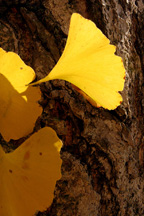
Gingko Talk,
Tour & Sale
Saturday, October 20
10 a.m.-Noon
Join us for a program featuring this "living fossil."
Ginkgo saplings will be for sale.
Andrea Wulf
Historian and Author of Founding Gardeners
Sunday, November 11
1:30-3:00 p.m.
Blandy Library
In this illustrated talk, Andrea Wulf examines the lives of our Founding Fathers through the lens of gardening and agrarianism. She explores the lives of Presidents Washington, Jefferson, Adams, and Madison, and draws on the deep relationship each had with plants. Based on her best-selling book, Founding Gardeners.
Book signing and tea reception to follow
Co-sponsored with the Colonial Dames of America, Chapter XXIII |
|
2012 Summer Camp
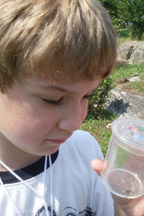
Young scientists explore nature at 2012 Blandy Summer Camp.
Click the photo for a camp slideshow. |
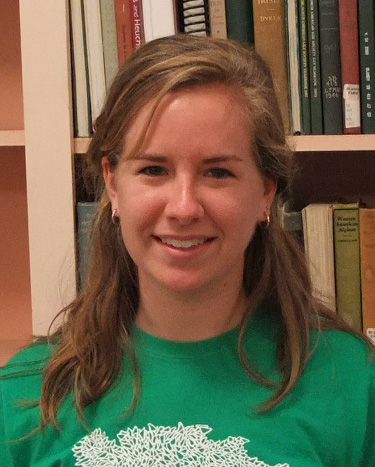
Staige Davis Wins Callahan Award REU Student Staige Davis earned the Tom Callahan Award for Undergraduate Research for her presentation at the student research forum Aug. 1. A student at UVa., Staige's research involved the response of bumblebee colony foraging behavior to changes in floral resource availability. She was mentored by graduate student Rosemary Malfi. The award is given in memory of former FOSA Board member and National Science Foundation researcher Tom Callahan, who lost his battle with cancer in 1999. The award is given to the student that gives the best presentation based on scientific merit and presentation style. |
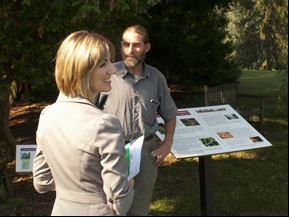 | |
Hear the Trees!
TV3 Winchester meteorologist Cassie Behofist interviews Arboretum curator T'ai Roulston about the Dial-A-Tree program. Click the photo to watch the interview. |
|
|
|
|
|
Celebrate Fall in Virginia at ArborFest
 Arboretum's Fall Festival is Oct. 13 & 14 Arboretum's Fall Festival is Oct. 13 & 14
The Arboretum's 19th annual fall festival is set for Saturday and Sunday, Oct. 13-14, from 9 a.m. to 4:30 p.m. both days.
ArborFest features a fall plant sale, guided tours, hay rides, and scarecrow making. New this year, a special Children's Storytime will feature a reading of "The Lorax" by Dr. Seuss.
ArborFest underwriter Bartlett Tree Experts will be on hand to answer tree questions, and sponsor Shade Tree Farm will demonstrate their huge tree spade by moving a large pine tree from a nursery area to a permanent spot along the Arboretum border. Visitors can follow the action on a hay ride to see the entire process.
On Saturday visitors can also hitch a ride on a hay wagon to help plant trees near the Arboretum's front entrance on Route 50. Workers will prepare planting sites for more than two dozen native trees, including oak, hickory, and tulip poplar.
The Blandy Sketch Group will host a reception to kick off their annual fall art show in the dining room Saturday, and FOSA Life Members are invited to a reception Sunday in the new Blandy field lab.
Guided walks by the Virginia Native Plant Society and the Audubon Society will provide additional opportunities to explore the Arboretum grounds.
ArborFest is underwritten by Bartlett Tree Experts, with support from sponsors Shade Tree Farm, Nancy Sanders Video Production, Nibblins,
radio station Q102, and Valley Health. For more information call 540-837-1758 Ext. 224. |
|
Lab Dedication Marks New Era
August 1 was a doubly exciting day at Blandy. That first Wednesday of August, as usual, was the day of our annual Summer Research Forum, when we showcase the research from all of our REU and many of our graduate students for the entire Blandy community. This year the day also featured the formal dedication of the new Blandy Field Lab. Over 100 supporters and members of the project team attended a morning ceremony to mark this historic moment.
 | |
John Hawley, Associate Dean for Sciences in the College of Arts & Sciences, at the dedication of the new Blandy Field Lab. |
The 4000-square foot building, designed by Train and Partners, will not only usher in a new era of research at Blandy, its green design and construction will establish a new standard for future building projects here.
We were very honored by the attendance of a number of special guests who helped with the celebration. Dave Stegmaier spoke on behalf of Congressman Frank Wolf. Congressman Wolf chairs the House Subcommittee on Commerce, Justice, Science, and Related Agencies and has a long-standing and deserved reputation as a champion for investment in the sciences. His subcommittee has jurisdiction over the National Science Foundation budget, and NSF funding played an instrumental role in the lab's construction.
Chris Weaver represented Lantz Construction, the general contractor for the project. Chris, Gerard Folio, and especially their on-site project manager Bob Baer did a fantastic job maintaining a smooth and uninterrupted construction schedule. Lantz broke ground on the project on September 28, and we moved into a completed lab just eight months later. Of course the dedication and high quality workmanship from their subcontractors was critical in ensuring the quality of the project.
John Hawley, who began his term as Associate Dean for Sciences for UVa's College of Arts & Sciences just weeks earlier, made his first trip to Blandy for the dedication. The College played a critical role in the project, and this dream would never have been realized without the support from Dean Meredith Woo, Senior Associate Dean Rick Myers, Director of Space Planning and Management Anna Towns, and Professor Hawley's predecessor Jim Galloway. John spoke eloquently on the role of science in the University, Blandy's role in science training, and the issue most vital to everything the University of Virginia does: How does all of this continue the Jeffersonian vision?
This new lab was an effort many years in the making, and it was wonderful to have so many who had a hand in it present for the celebration. Folks involved from the early concept stages through construction and even the dedication itself included the University's project managers Kate Meyer and Dave Paley; Senior Academic Facility Manager from the Provost Office, Dick Minturn; Luis Carrazana from the Office of the Architect; the Chair of the Department of Environmental Scinces, Pat Wiberg; the Blandy faculty and staff; and many members of the Foundation of the State Arboretum. Unable to attend was former Blandy Director Michael Bowers, whose leadership originally established the financial path that eventually made the project feasible.
Also in attendance were the students themselves. The 2012 Blandy research community included 25 full-time undergraduate and graduate students, all of whom were the direct beneficiaries of the effort to make the lab a reality. The lab not only took care of their research needs, it became the place where they and the faculty gathered all summer and learned from one another. It created a stronger, more cohesive sense of community among the grads and undergrads at Blandy. The students filled the building with activity and energy, and later that afternoon, they shared with their peers and the public the science that had kept them so excited and motivated all summer long. |
|
New Trees Will Enhance Blandy's Forest
The Arboretum received a $3,000 grant from the Virginia Department of Forestry to convert an acre of mowed grass and weedy woodlot into a mixed hardwood deciduous forest near the front entrance of the property. This planting will expand and improve the forest by replacing a non-native fescue grassland with native canopy trees such as oak, black cherry, hickory, and tulip poplar.
To minimize invasion by invasive forbs and shrubs, we will disturb the grass only enough to establish the trees, then let the 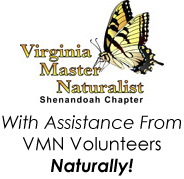 trees shade out the grass over time. In the adjacent understory of the established woodlot, we will continue pulling out invasive understory plants, mainly shrub honeysuckle, before the planting date. This process was initiated by volunteers with the local chapter of Virginia Master Naturalists, whose amazing work showed that, with enough work, we could reclaim the forest for Virginia plants. trees shade out the grass over time. In the adjacent understory of the established woodlot, we will continue pulling out invasive understory plants, mainly shrub honeysuckle, before the planting date. This process was initiated by volunteers with the local chapter of Virginia Master Naturalists, whose amazing work showed that, with enough work, we could reclaim the forest for Virginia plants.
After an additional shrub pull this fall, we will plant into the understory small native trees such as redbud and pawpaw, and long-lived shrubs such as spicebush, as well as future canopy trees. A combination of shrub honeysuckle and voracious deer have prevented the establishment of any new native woody plants in that area. All trees will have to be fenced, and Broomley Farm near Charlottesville has donated all of the cages needed for the planting of the 150 planned trees.
While Blandy staff will prepare the holes for planting, the actual tree plantings will be done as educational events that highlight the importance of trees for wildlife, water retention and control, and carbon storage. We are offering planting opportunities to K-12 students during class field trips and to other groups that would like to be involved.
One of these events will take place on the Saturday of Arborfest, October 13 at 3 p.m. If you'd like to plant a tree, look for the hay wagon on the event field at 3 p.m., and leave the driving to us. Kids are welcome. Any inquiries can be directed to T'ai Roulston (tai.roulston@virginia.edu). |
|
Fall Programs Feature Hikes, Bikes, & More
If this fall's public program series had a theme, it might be "Bodies In Motion."
September began with our second Blandy bicycle tour, which will be followed by an evening of silent walking, guided meditation, and personal reflection.
We next turn our eyes upward, first in an exploration of the night sky, then a bit closer to Earth as we watch hawks on their southward migration.
There will be two full moon hikes this fall, both in October. We'll tour the ginkgo grove following a presentation and plant sale. And we'll cap off the season by tracking the movements of a holiday tree from its beginnings on a tree farm to the living room.
Not every program will have us up and moving. In October, FOSA will co-host the fifth annual program with Shenandoah University's Department of Environmental Studies. This talk, on emerging insect pests, will be on the SU campus.
 And you won't want to miss a special talk by British author and historian, Andrea Wulf. She will speak in the Blandy library about her award-winning book, Founding Gardeners. Her talk will be followed by a book signing and tea reception, all co-sponsored with the Colonial Dames of America, Chapter XXIII. And you won't want to miss a special talk by British author and historian, Andrea Wulf. She will speak in the Blandy library about her award-winning book, Founding Gardeners. Her talk will be followed by a book signing and tea reception, all co-sponsored with the Colonial Dames of America, Chapter XXIII.
We've packed a lot into the fall season, exploring our world from tiny bark-boring beetles to the moon and beyond. Check the web for details, and call Shari to register at 540-837-1758 Ext. 224. But don't delay - some programs fill quickly.
Click here to see all fall programs.
|
Education Director Named to NSTA Board
Candace Lutzow-Felling, Blandy's Director of Education, was elected to serve a three-year term on the 13-member Board of the National Science Teachers' Association (NSTA) as the Director of Informal Science Education.
The NSTA Board of Directors consists of three elected officers within the Presidential chain of command (president-elect, president, and past-president) and 10 directors
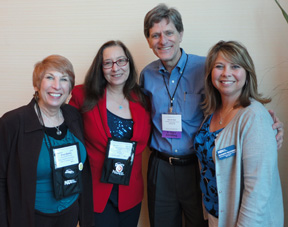 | |
Candace Lutzow-Felling with past NSTA Informal Science Education Directors Elsa Bailey, David Heil, and Elizabeth Mulkerrin at the 2012 NSTA national conference in Indianapolis. |
representing the 10 service divisions within the organization (Preschool & Elementary, Middle Level, High School, College, Informal Science, Research in Science Education, Coordination & Supervision, Preservice Teacher Preparation, Multicultural/Equity in Science Education, and Professional Development). An appointed treasurer and NSTA's Executive Director round out the Board and serve as non-voting members.
NSTA's mission is "... to promote excellence and innovation in science teaching and learning for all." NSTA serves 60,000 members and over 400,000 active non-members as an advocate for science education with Congress and the Executive Branch of government, producer of excellent and popular print and web-based resources for teachers, and provider of annual regional and national conferences which draw thousands of educators to each event.
Informal science education involves any science learning outside of the classroom that is lead by someone other than a classroom teacher. All of Blandy's education programs for PreK-12 students and for the general public fall into the realm of informal science education.
When asked about the significance of her appointment and what she plans to do during her three-year term, Candace replied "This is an exciting time for Informal Science Education (ISE) within NSTA. The important role of learning experiences in non-school settings is gaining recognition and NSTA recently has strengthened its support for informal science learning for all preK-12 students.
"Learning at museums, science and technology centers, zoos and aquariums, gardens and arboreta provides opportunities for students to explore and deepen their understanding of science concepts and classroom. As the Informal Science Education Director, I will work to support and advance NSTA's goals for ISE with a focus on four main initiatives:
* Partnerships. Strengthen partnerships between NSTA and national ISE organizations;
* Capacity building. Identify ISE leaders within the 18 NSTA geographic districts and facilitate science collaborations with NSTA District Directors;
* Contributions & Connections. Continue to highlight ISE STEM contributions and innovations at NSTA regional and national conferences;
* Communication. Further develop social networking and other communication strategies between NSTA's informal and formal science educators. "
Congratulations Candace! |
|
|
|
Teachers Learn Watershed Science at Bay Academy
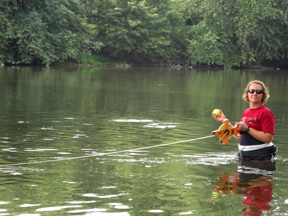 | |
Quincy Click from Fredericksburg measures the veolocity of the water flow in the Shenandoah River. Click the image for more photos. |
Thirteen elementary, middle, and high school teachers from around the commonwealth and West Virginia attended Blandy's Chesapeake Bay Watershed Academy August 6-10 and learned how to take their students outside to conduct a meaningful watershed education experience (MWEE). The Chesapeake Bay Agreement 2000, signed by the governors of Virginia, New York, Maryland, Pennsylvania, and West Virginia mandates that all public school students in their states engage in at least one MWEE before graduation. The components of an effective MWEE are to engage students in an investigation, include an outdoor experience, be based on a planned and structured lesson, consider a watershed as a system, be sustained over a period of time (not just a one-time experience), include information sharing, and be designed for ALL students. This sounds complex and it is! During our five-day Academy the Blandy Education Team broke down all of these components and led teachers through a series of meaningful watershed education experiences. At the end of the Academy participants created a lesson plan for their students using some of the knowledge, skills and resources they gained during the week.
When asked what the most valuable aspects of the Academy were, teachers responded:
- Lots of science background information learned and ways to use this in the classroom;
- Field investigation experiences;
- Learning the importance of watersheds;
- Collaborating with other teachers;
- Learning where water goes besides out of the faucet;
- Learning how to transform a boring lab into a more hands-on lab;
- Learning how to connect field work to classroom work and the Virginia science standards of learning;
- All the lessons, materials, websites, and contact information to take back to the classroom;
- Learning that teaching about watersheds can be fun!
As a result of their Bay Academy training teachers stated that they plan to:
- teach students what a watershed is and teach them how to take care of this precious resource;
- make MWEE lessons much more interactive;
- not only teach a watershed unit but also incorporate watershed learning into other lessons;
- share new knowledge and skills with colleagues;
- take students outdoors for a MWEE field investigation!
We thoroughly enjoyed our time teaching and learning alongside this group of committed, enthusiastic teachers. We are thrilled that so much was learned and that each teacher will return to his or her classroom committed to teaching watershed science and striving to have his/her students learn about watershed systems outdoors. We could not have asked for a more rewarding outcome.
Our Chesapeake Bay Academy was funded by the National Oceanic and Atmospheric Association Chesapeake Bay Watershed Education Training Program (NOAA B-WET), the Virginia Resource-Use Education Council, and the Virginia Department of Education. |
|
|
|
|